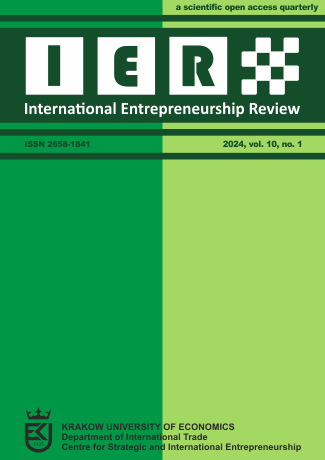Unveiling the dynamic job-matching landscape in the post-COVID-19 labour market through the lens of the Beveridge curve

Abstract
Objective: The objective of the article is the identification and assessment of labour market operation efficiency and stability of matching mechanisms from the microstructure perspective of labour market dynamics via the relationship between distortions in the level and slope of the Beveridge curve. We studied the US labour market dynamics and identified potential structural changes in the job matching mechanisms. The long-term relationship between the level and slope of the Beveridge curve suggested that the underlying level of unemployment matched the labour market’s elasticity in response to changes in job vacancies.
Research Design & Methods: The main design of our article was a quantitative analysis of the Beveridge curve shifts. We used a data set consisting of monthly information on job vacancies and the unemployment rate of the US labour market from 2000 to 2022. Using a dynamic rolling scheme with a fixed window size, we extracted time series parameters of the Beveridge curve. We then proceed to apply the VECM(1) model to establish the relationship between these parameters.
Findings: We have found the stability of the matching mechanism in the long term and the relatively weaker or instantaneous adjustment mechanisms in the short term. We also addressed the absence of evidence regarding Granger causality and its implications.
Implications & Recommendations: The identification of elasticity of the Beveridge curve should guide policymakers towards integrated and adaptive strategies that address both structural and dynamic aspects of the labour market. Regular monitoring and evaluation will be crucial to ensuring that policies remain effective in the evolving economic landscape.
Contribution & Value Added: Unlike previous literature on the subject, which primarily relied on static analyses and limited time frames, we took a pioneering step by incorporating monthly data on job vacancies and unemployment rate spanning over two decades, from 2000 to 2022. This inclusion allowed us to encompass the period of the COVID-19 outbreak, providing a comprehensive understanding of the matching mechanism’s behaviour as a cornerstone for entrepreneurship during times of extraordinary economic stress.
Keywords
entrepreneurship, labour market, Beveridge curve shape, distortions in the labour market, dynamic econometric analysis, labour market tightness, unemployment elasticity
Author Biography
Małgorzata Snarska
Małgorzata Snarska is an Assistant Professor at the Department of Financial Markets, Cracow University of Economics and a visiting Professor at IESEG School of Management, Paris, France. Holds a PhD degree in statistical physics from the Faculty of Physics, Astronomy and Applied Computer Science of Jagiellonian University, Poland. Her research interests include time series analysis, microeconomic models, multivariate statistical analysis, functional data analysis, and theory and economic applications of robust and nonparametric statistics.
Jerzy P. Rydlewski
Jerzy P. Rydlewski is an Assistant Professor at the AGH University of Krakow, Faculty of Applied Mathematics. PhD degree in mathematical statistics from the Faculty of Mathematics and Computer Science of Jagiellonian University, Poland. His research interests include multivariate statistical analysis, functional data analysis, and theory and economic applications of robust and nonparametric statistics.
References
- Abraham, K., & Katz, L. (1986). Cyclical unemployment: Sectoral shifts or aggregate disturbances?. Journal of Political Economy, 94(3), 507-522. http://doi.org/10.1086/261387
- Aoki, M., & Yoshikawa, H. (2007). Reconstructing macroeconomics - A perspective from statistical physics and combinatorial stochastic processes. Cambridge: Cambridge University Press. https://doi.org/10.1017/cbo9780511510670
- Dutu, R., Holmes, M.J., & Silverstone, B. (2016). Modelling a regime-shifting Beveridge curve. Bulletin of Economic Research, 68(1), 90-104. https://doi.org/10.1111/boer.12048
- Ebrahimy, E., & Shimer, R. (2010). Stock-flow matching. Journal of Economic Theory, 145(4), 1325-1353. https://doi.org/10.1016/j.jet.2010.02.012
- Elsby, M.W., Michaels, R., & Solon, G. (2009). The ins and outs of cyclical unemployment. American Economic Journal: Macroeconomics, 1(1), 84-110. https://doi.org/10.1257/mac.1.1.84
- Elsby, M.W., & Michaels, R. (2013). Marginal jobs, heterogeneous firms, and unemployment flows. American Economic Journal: Macroeconomics, 5(1), 1-48. https://doi.org/10.1257/mac.5.1.1
- Elsby, M.W., Michaels, R., & Ratner, D. (2015). The Beveridge curve: A survey. Journal of Economic Literature, 53(3), 571-630. https://doi.org/10.1257/jel.53.3.571
- Granger, C.W.J. (1969). Investigating causal relations by econometric models and cross-spectral methods. Econometrica, 37(3), 424-438. https://doi.org/10.2307/1912791
- Hall, R.E. (2005a). Employment efficiency and sticky wages: Evidence from flows in the labor market. The Review of Economics and Statistics, 87(3), 397-407. https://doi.org/10.1162/0034653054638346
- Hall, R.E. (2005b). Employment fluctuations with equilibrium wage stickiness. American Economic Review, 95(1), 50-65. https://doi.org/10.1257/0002828053828482
- Hall, R.E., & Milgrom, P.R. (2008). The limited influence of unemployment on the wage bargain. American Economic Review, 98(4), 1653-1674. https://doi.org/10.1257/aer.98.4.1653
- Herz, B., & van Rens, T. (2020). Accounting for mismatch unemployment. Journal of the European Economics Association, 18(4), 1619-1654. https://doi.org/10.1093/jeea/jvz018
- Holmes, M.J., & Otero, J. (2020). The Beveridge Curve across US States: new insights from a pairwise approach. Oxford Bulletin of Economics and Statistics, 82(2), 405-424. https://doi.org/10.1111/obes.12337
- Johansen, S. (1988). Statistical analysis of cointegration vectors. Journal of Economic Dynamics and Control, 12(2-3), 231-254. https://doi.org/10.1016/0165-1889(88)90041-3
- Lazaryan, N., & Lubik, T.A. (2019). Global dynamics in a search and matching model of the labor market. Economic Theory, 68, 461-497. https://doi.org/10.1007/s00199-018-1131-y
- Michaillat, P. (2012). Do matching frictions explain unemployment? Not in bad times. American Economic Review, 102(4), 1721-1750. https://doi.org/10.1257/aer.102.4.1721
- Michaillat, P., & Saez, E. (2021). Beveridgean unemployment gap. Journal of Public Economics Plus, 2, 100009, https://doi.org/10.1016/j.pubecp.2021.100009
- Okun, A.M. (1973). Upward mobility in a high-pressure economy. Brooking Papers on Economic Activity, 1, 207-261. https://doi.org/10.2307/2534087
- Pissarides, C.A. (2009). The unemployment volatility puzzle: Is wage stickiness the answer?. Econometrica, 77(5), 1339-1369. https://doi.org/10.3982/ECTA7562
- Shimer, R. (2005). The cyclical behavior of equilibrium unemployment and vacancies. American Economic Review, 95(1), 25-49. https://doi.org/10.1257/0002828053828572
- Shimer, R. (2007). Mismatch. American Economic Review, 97(4), 1074-1101. https://doi.org/10.1257/aer.97.4.1074
